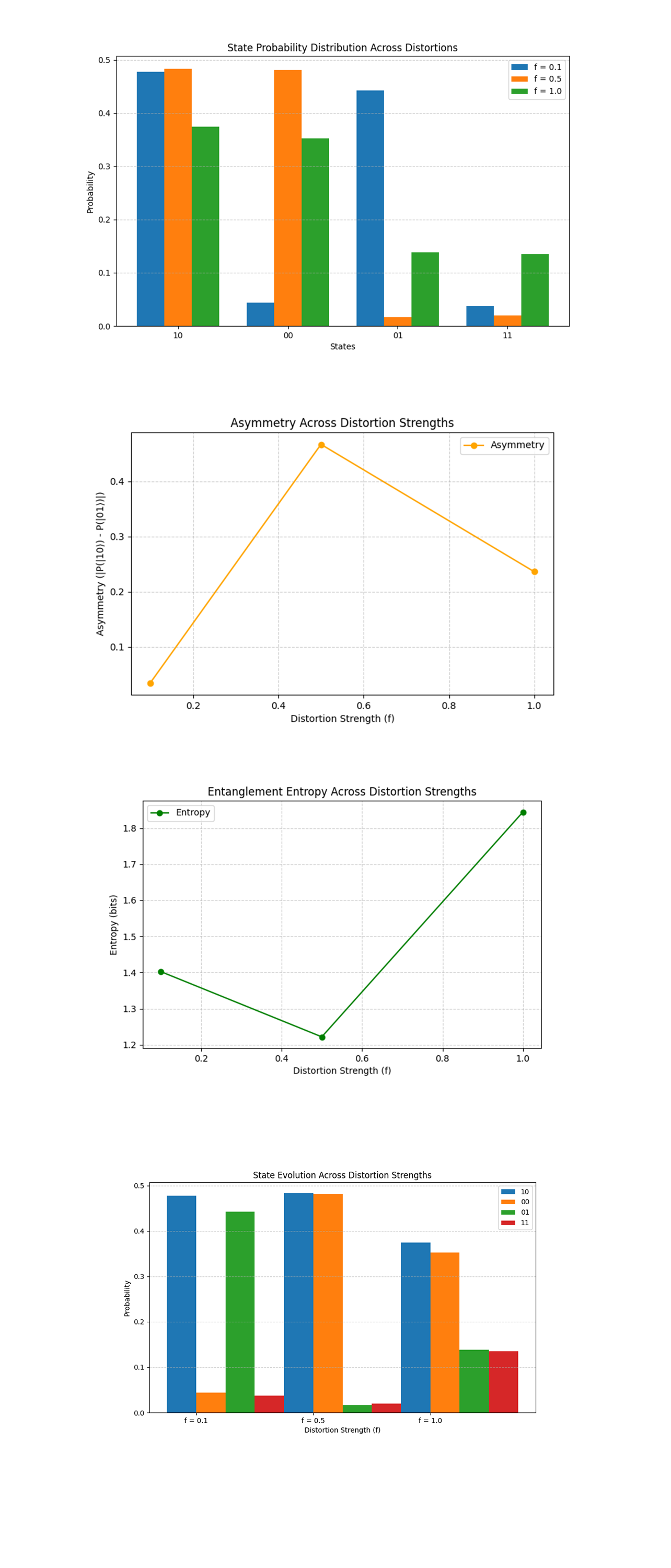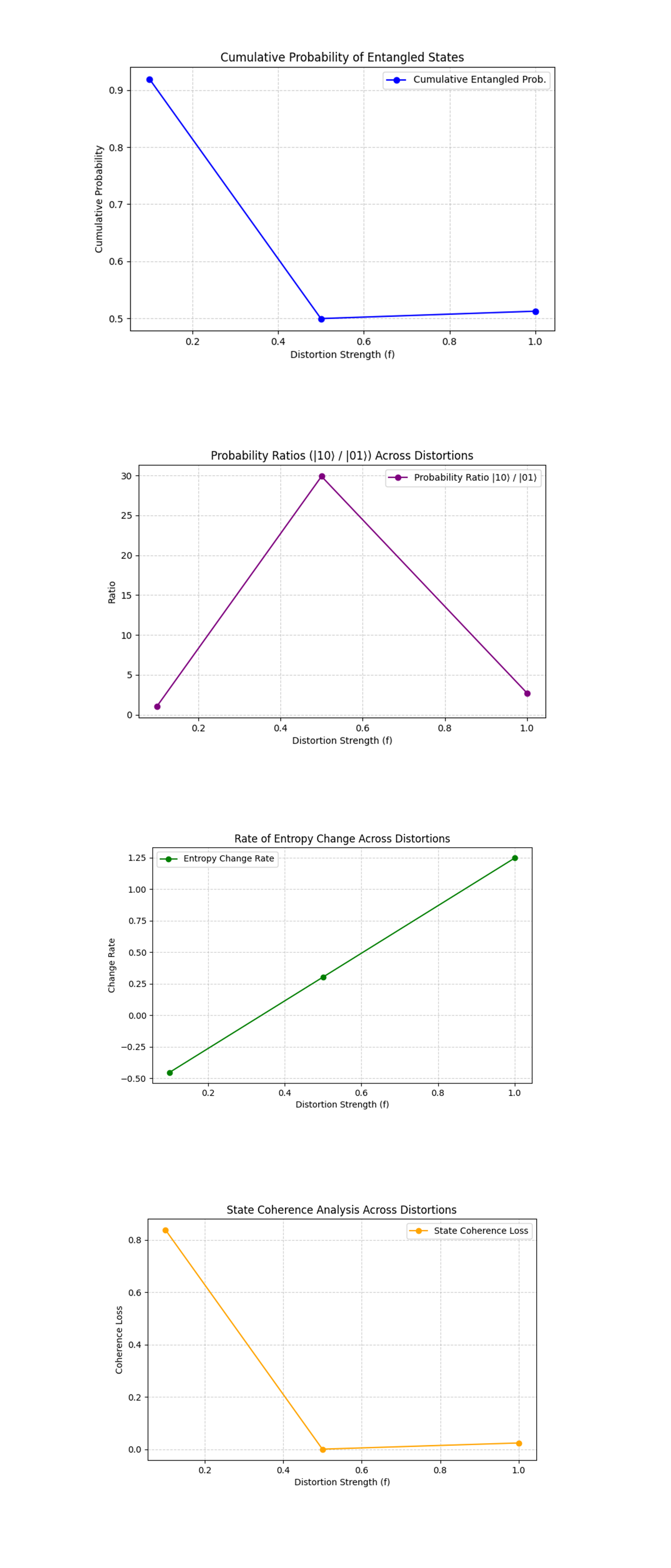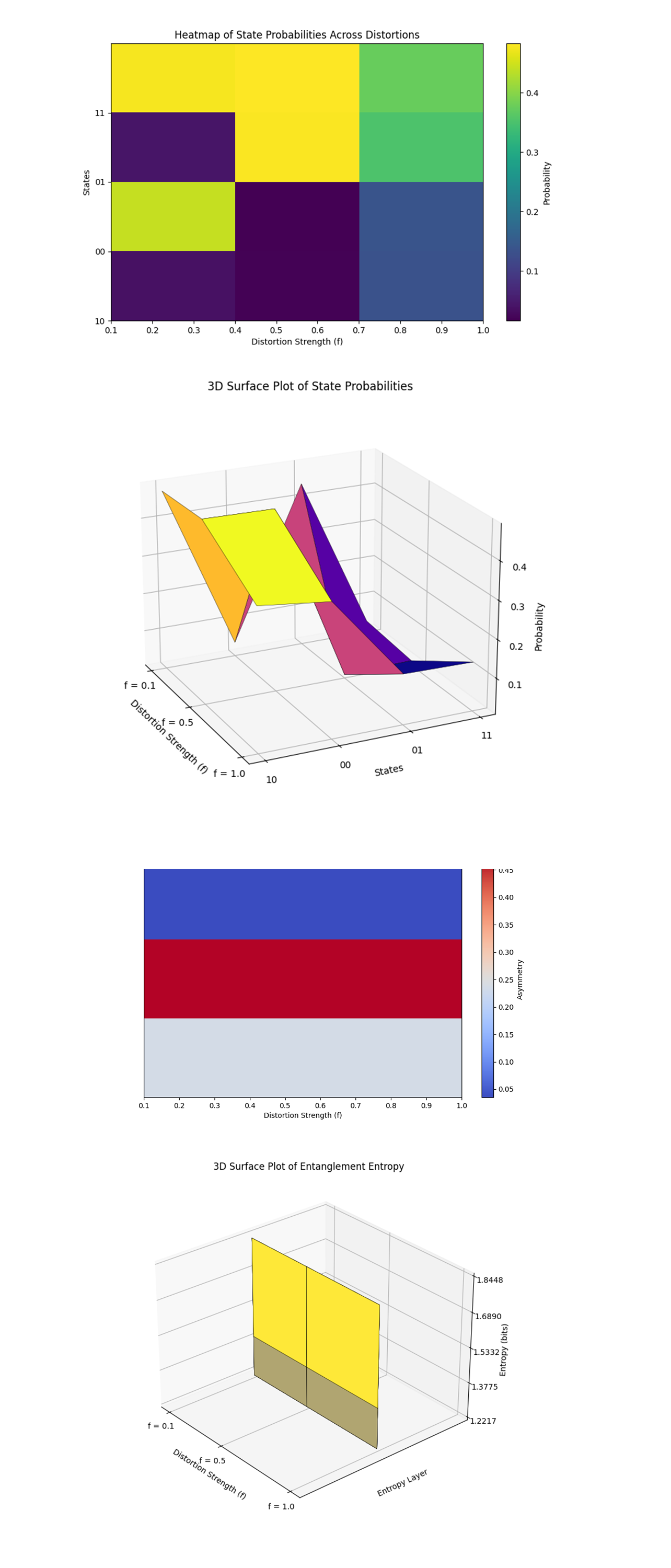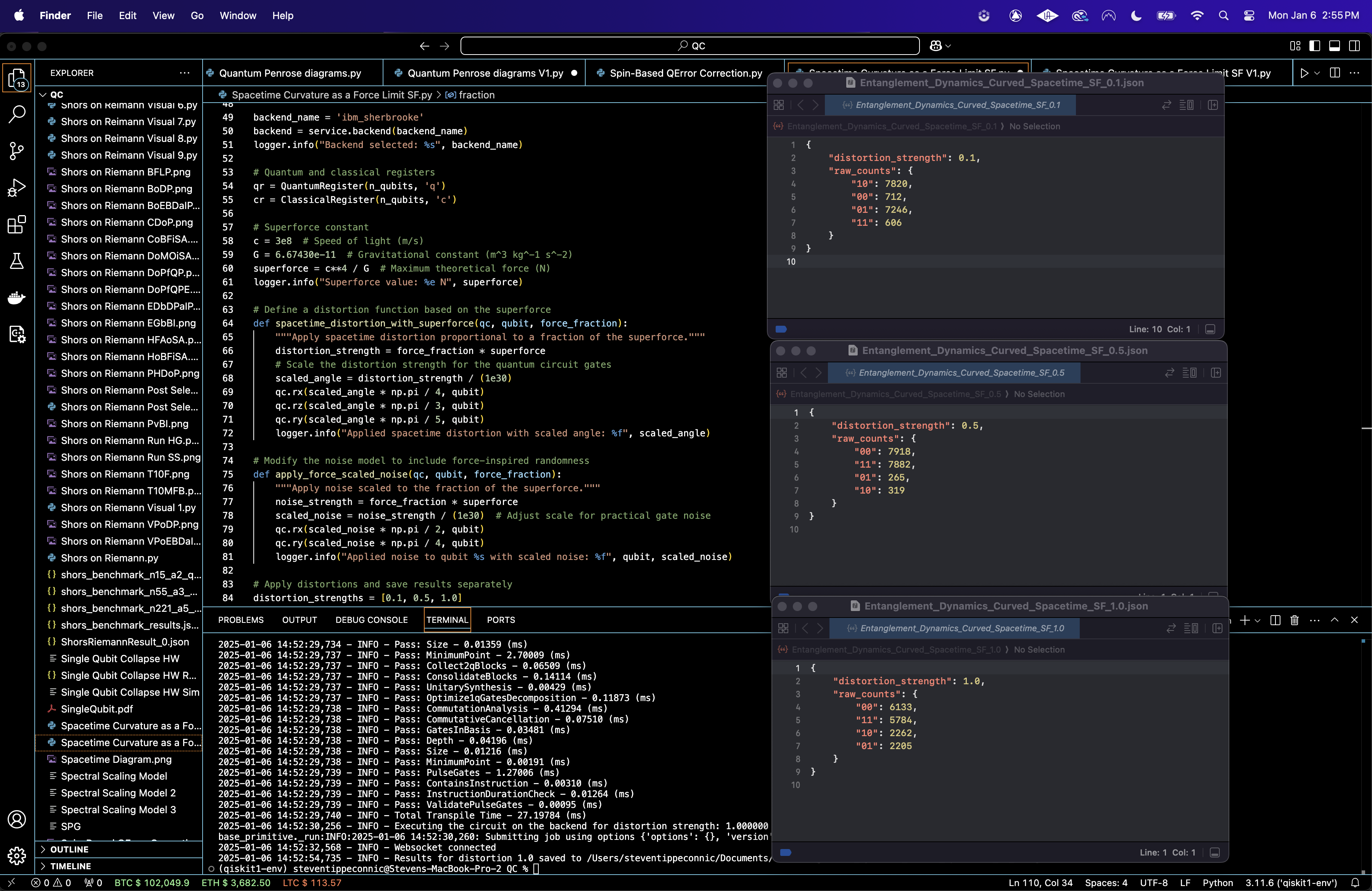Exploring Entanglement Dynamics in Curved Spacetime Under the Influence of the Superforce '(c^4)/G' as proposed by Salvatore Pais on IBM's 127-Qubit Quantum Computer
1. Problem
Einstein’s field equations describe the curvature of spacetime due to mass-energy:
R_μν - 1/2g_μν R + Λg_μν = (8πG)/(c^4) T_μν
Here, G is the gravitational constant, and c is the speed of light. The Superforce is the reciprocal of (8πG)/(c^4):
F_Planck = (c^4)/G
It represents the maximum theoretical force in nature and provides the scale for spacetime distortions.
A Bell state is used as the starting point for this experiment because it maximally entangles two qubits. The Bell state is given by:
∣ψ⟩ = 1/sqrt(2) * (∣10⟩ + ∣01⟩)
2. Setup the Quantum Circuit
A quantum register qr of 2 qubits and a classical register cr of 2 bits are initialized.
The Bell state is created:
Apply a Hadamard gate H to the first qubit:
H ∣0⟩ = 1/sqrt(2) * (∣0⟩+∣1⟩)
Apply a controlled-X (CNOT) gate between the first and second qubits:
CNOT(∣ψ⟩ ⊗ ∣0⟩) = 1/sqrt(2) * (∣10⟩ + ∣01⟩)
3. Spacetime Distortions
A distortion function is defined to model the effect of spacetime curvature:
F_distortion = f * F_Planck
where f is the fraction of the Superforce. The distortion is applied using rotation gates:
RX(θ) = [ cos(θ/2), -i sin(θ/2)
-i sin(θ/2), cos(θ/2) ]
with θ = ((F_distortion)/(1 * 10^30)) * π/4
Similar rotations are applied using RY and RZ gates with scaled angles:
RY: θ = ((F_distortion)/(1 * 10^30)) * π/5
RZ: θ = ((F_distortion)/(1 * 10^30)) * π/3
Three distortion strengths are tested: f = 0.1, 0.5, 1.0.
4. Noise Model
Noise proportional to the distortion strength is added:
F_noise = f * F_Planck
RX and RY gates are applied with scaled noise angles to simulate environmental noise.
5. Measurement
The circuit measures both qubits, and the results are stored in the classical register. Counts for each computational basis state (∣00⟩, ∣01⟩, ∣10⟩, ∣11⟩) are extracted.
6. Execution and Results
The circuit is transpiled for ibm_sherbrooke with optimization level 3. For each distortion strength f, the circuit is executed independently with 16,384 shots. Results are saved to three Json files.
7. Analysis
The normalized counts for each state (∣00⟩, ∣01⟩, ∣10⟩, ∣11⟩) are analyzed. The absolute difference between ∣10⟩ and ∣01⟩ probabilities is calculated to quantify directional bias:
Asymmetry = ∣ P(∣10⟩) − P(∣01⟩) ∣
Entanglement entropy is computed using the formula:
S = −∑(p_i)log_2(p_i),
i
where p_i is the probability of state i.
"distortion_strength": 0.1,
"raw_counts": {
"10": 7820,
"00": 712,
"01": 7246,
"11": 606
}
"distortion_strength": 0.5,
"raw_counts": {
"00": 7918,
"11": 7882,
"01": 265,
"10": 319
}
"distortion_strength": 1.0,
"raw_counts": {
"00": 6133,
"11": 5784,
"10": 2262,
"01": 2205
}
Weak distortions (f = 0.1) introduce minimal asymmetry and preserve entanglement entropy. Stronger distortions (f = 0.5 and f = 1.0) cause noticeable shifts in probabilities and reduced entropy, showing partial decay of entanglement.
Distortions amplify asymmetry, with one entangled state ( ∣01⟩ or ∣10⟩) becoming more likely than the other. This confirms spacetime inspired distortions break the symmetry of the Bell state. Entropy decreases as distortion strength increases, meaning a gradual loss of entanglement.

The State Probability Distribution Across Distortions above (code below) shows at f = 0.1, the probabilities for ∣10⟩ and ∣01⟩ are nearly equal (~50%), with negligible contributions from ∣00⟩ and ∣11⟩. At f = 0.5, the probabilities for ∣10⟩ and ∣01⟩ begin to diverge, with a slight increase in ∣00⟩ and ∣11⟩. At f = 1.0, there is a significant redistribution of probabilities, with ∣00⟩ and ∣11⟩ gaining more weight while ∣10⟩ and ∣01⟩ lose their dominance. Thus, weak distortions (f = 0.1) minimally affect the entanglement structure, preserving the balance of ∣10⟩ and ∣01⟩. Stronger distortions (f = 0.5 and f = 1) introduce significant state mixing, reducing the dominance of the entangled states (∣10⟩, ∣01⟩) and increasing the contributions of non-entangled states (∣00⟩, ∣11⟩). Spacetime inspired distortions disrupt the entangled Bell state, leading to state mixing and reduced coherence in the system.
The Asymmetry Across Distortion Strengths above (code below) shows the asymmetry between ∣10⟩ and ∣01⟩ probabilities increases sharply at f = 0, peaking at ~0.4, and decreases at f = 1.0. At moderate distortions (f = 0.5), the directional bias introduced by spacetime curvature is most pronounced, favoring one state over the other. At strong distortions (f = 1.0), the increased state mixing reduces asymmetry as the probabilities of ∣10⟩ and ∣01⟩ converge toward a more balanced distribution. Thus, spacetime distortions exhibit non-linear effects on asymmetry, with moderate distortions causing the greatest directional bias. This suggests a transition point where distortions overcome the coherence of the Bell state.
The Entanglement Entropy Across Distortion Strengths above (code below) shows at f = 0.1, the entropy is ~1.4 bits, indicating significant entanglement. At f = 0.5, entropy drops to ~1.2 bits, reflecting reduced entanglement. At f = 1.0, entropy increases to ~1.8 bits, suggesting a shift toward a more mixed, less coherent state. Spacetime distortions have a complex effect on entanglement entropy, with moderate distortions causing the most degradation, while strong distortions lead to a highly mixed quantum state.
The State Evolution Across Distortion Strengths above (code below) shows at f = 0.1, ∣10⟩ and ∣01⟩ dominate, with negligible contributions from ∣00⟩ and ∣11⟩. At f = 0.5, ∣10⟩ and ∣01⟩ probabilities decrease as ∣00⟩ and ∣11⟩ gain weight. At f = 1.0, all states have comparable probabilities, reflecting significant state mixing. Weak distortions maintain the entangled state structure. Moderate distortions lead to noticeable state mixing and reduced coherence. Strong distortions fully disrupt the entangled state, producing a highly mixed quantum state.

The Cumulative Probability of Entangled States above (code below) shows at f = 0.1, the cumulative probability of entangled states (∣10⟩ + ∣01⟩) is approximately 0.9, indicating strong entanglement. At f = 0.5, the cumulative probability drops significantly to 0.5, reflecting a disruption in entanglement. At f = 1.0, the cumulative probability stabilizes at 0.5, showing no further decrease despite strong distortions. Cumulative entangled state probability provides a direct metric for tracking the robustness of the entanglement under distortions. The sharp decline at moderate distortions shows the fragility of the entangled state during transitional phases.
The Probability Ratios (∣10⟩/∣01⟩) above (code below) shows at f = 0.1, the ratio is close to 1, indicating near symmetry between ∣10⟩ and ∣01⟩. At f = 0.5, the ratio peaks dramatically (~30), suggesting that one state (∣10⟩) becomes overwhelmingly dominant. At f = 1.0, the ratio decreases again, approaching a balanced distribution. Probability ratios reveal the directional effects of spacetime distortions on entangled states. The sharp peak at f = 0.5 shows the strongest directional bias, aligning with the asymmetry findings from earlier.
The Rate of Entropy Change above (code below) shows at f = 0.1, the entropy change rate is negative, indicating a slight decrease in randomness as distortions begin to affect the system. At f = 0.5, the change rate becomes positive and accelerates rapidly. At f = 1.0, the rate of entropy change peaks, showing the system rapidly transitions to a mixed, high entropy state. Entropy change rate captures the dynamic effects of spacetime distortions on quantum randomness. The positive acceleration shows how quickly entanglement breaks down as distortions increase.
The State Coherence Analysis above (code below) shows at f = 0.1, the coherence loss is minimal, with the entangled states (∣10⟩ + ∣01⟩) dominating over non-entangled states (∣00⟩ + ∣11⟩). At f = 0.5, coherence loss increases significantly as non-entangled states begin to mix into the system. At f = 1.0, coherence loss stabilizes, indicating a fully mixed state with equal contributions from all states.

The Heatmap of State Probabilities Across Distortions above (code below) shows the gradual loss of entanglement as distortions increase. The brighter colors for ∣10⟩ and ∣01⟩ at low distortions show the robustness of entanglement, while the dimming at higher distortions reveals coherence loss. At f = 0.1, ∣10⟩ and ∣01⟩ dominate at lower distortion strengths. At f = 0.5, probabilities become more evenly distributed, with noticeable contributions from ∣00⟩ and ∣11⟩. At f = 1.0, probabilities drop significantly, showing a transition to a mixed state.
The 3D Surface Plot of State Probabilities above (code below) adds depth to the heatmap analysis, showing how distortions create valleys and plateaus in the state probabilities. The flattening surface at higher distortions shows the system’s transition to a mixed state. Peaks are visible for ∣10⟩ and ∣01⟩ at lower distortions, signifying their dominance. As distortions increase, the surface flattens, indicating a more uniform distribution of probabilities across all states.
The Heatmap of Asymmetry Across Distortions above (code below) shows the asymmetry dynamics, with brighter colors indicating higher asymmetry. The peak at moderate distortions suggests that this is the critical point where directional effects are strongest. Asymmetry between ∣10⟩ and ∣01⟩ probabilities is low at f = 0.1. The asymmetry peaks at f = 0.5, indicating a strong directional bias introduced by the distortions. At f = 1.0, asymmetry decreases again, signaling a transition to a mixed state.
The 3D Surface Plot of Entanglement Entropy above (code below) shows the dynamic evolution of entropy, and the critical points of entanglement breakdown. Peaks in the plot correspond to the maximum randomness introduced by distortions. Entropy is low at f = 0.1, consistent with strong entanglement and low randomness. Entropy increases sharply at f = 0.5, showing significant coherence loss and state mixing. At f = 1.0, entropy stabilizes at a high value, marking the transition to a fully mixed state.
In the end, this experiment investigated the dynamics of quantum entanglement under spacetime inspired distortions modeled by fractions of the theoretical Superforce (c^4)/G, as proposed by Salvatore Pais. By creating Bell states and introducing distortions through controlled quantum gate manipulations, this circuit analyzed the effects of weak, moderate, and strong distortions (f = 0.1, 0.5, 1.0) on entanglement entropy, state probabilities, and asymmetry. Results showed that weak distortions preserved entanglement, as shown by high entangled state probabilities and low entropy. Moderate distortions (f = 0.5) marked a critical transition, with significant coherence loss and asymmetry, while strong distortions (f = 1.0) led to a mixed state characterized by uniform probabilities and high entropy. For (c^4)/G, this means that it can act as a natural scaling framework to explore the fragility of quantum systems in extreme conditions. The experiment shows that spacetime curvature, or analogous forces on the scale of (c^4)/G, can significantly disrupt entanglement and coherence.
Code:
# Imports
import numpy as np
import json
import pandas as pd
import logging
from qiskit import QuantumCircuit, QuantumRegister, ClassicalRegister, transpile
from qiskit_ibm_runtime import QiskitRuntimeService, Session, SamplerV2
from qiskit.visualization import plot_histogram
from scipy.linalg import expm
import matplotlib.pyplot as plt
# Logging
logging.basicConfig(level=logging. INFO, format='%(asctime)s - %(levelname)s - %(message)s')
logger = logging.getLogger(__name__)
# Load calibration data
def load_calibration_data(file_path):
logger. info("Loading calibration data from %s", file_path)
calibration_data = pd. read_csv(file_path)
calibration_data.columns = calibration_data.columns.str.strip()
logger. info("Calibration data loaded successfully")
return calibration_data
# Select best qubits
def select_best_qubits(calibration_data, n_qubits):
logger. info("Selecting the best qubits based on T1, T2, and error rates")
qubits_sorted = calibration_data.sort_values(by=['\u221ax (sx) error', 'T1 (us)', 'T2 (us)'], ascending=[True, False, False])
best_qubits = qubits_sorted['Qubit'].head(n_qubits).tolist()
logger. info("Selected qubits: %s", best_qubits)
return best_qubits
# Load most recent calibration data
calibration_file = '/Users/Downloads/ibm_sherbrooke_calibrations_2025-01-06T17_46_19Z.csv'
calibration_data = load_calibration_data(calibration_file)
# Select best qubits for the experiment
n_qubits = 2
best_qubits = select_best_qubits(calibration_data, n_qubits)
# IBMQ
logger. info("Setting up IBM Q service")
service = QiskitRuntimeService(
channel='ibm_quantum',
instance='ibm-q/open/main',
token='YOUR_IBMQ_API_KEY_O-`'
)
backend_name = 'ibm_sherbrooke'
backend = service.backend(backend_name)
logger. info("Backend selected: %s", backend_name)
# Quantum and classical registers
qr = QuantumRegister(n_qubits, 'q')
cr = ClassicalRegister(n_qubits, 'c')
# Superforce constant
c = 3e8 # Speed of light (m/s)
G = 6.67430e-11 # Gravitational constant (m^3 kg^-1 s^-2)
superforce = c**4 / G # Maximum theoretical force (N)
logger. info("Superforce value: %e N", superforce)
# A distortion function based on the Superforce
def spacetime_distortion_with_superforce(qc, qubit, force_fraction):
"""Apply spacetime distortion proportional to a fraction of the superforce."""
distortion_strength = force_fraction * superforce
# Scale the distortion strength for the quantum circuit gates
scaled_angle = distortion_strength / (1e30)
qc.rx(scaled_angle * np.pi / 4, qubit)
qc.rz(scaled_angle * np.pi / 3, qubit)
qc.ry(scaled_angle * np.pi / 5, qubit)
logger. info("Applied spacetime distortion with scaled angle: %f", scaled_angle)
# Noise model
def apply_force_scaled_noise(qc, qubit, force_fraction):
"""Apply noise scaled to the fraction of the superforce."""
noise_strength = force_fraction * superforce
scaled_noise = noise_strength / (1e30)
qc.rx(scaled_noise * np.pi / 2, qubit)
qc.ry(scaled_noise * np.pi / 4, qubit)
logger. info("Applied noise to qubit %s with scaled noise: %f", qubit, scaled_noise)
# Apply distortions and save results
distortion_strengths = [0.1, 0.5, 1.0]
for fraction in distortion_strengths:
# Create a fresh quantum circuit for each distortion strength
qc = QuantumCircuit(qr, cr)
# Create Bell state
qc.h(qr[0])
qc. cx(qr[0], qr[1])
# Apply spacetime distortion
spacetime_distortion_with_superforce(qc, qr[1], fraction)
# Apply noise
apply_force_scaled_noise(qc, qr[1], fraction)
# Measure
qc.measure(qr, cr)
# Transpile
qc_transpiled = transpile(qc, backend=backend, optimization_level=3)
# Execute
with Session(service=service, backend=backend) as session:
sampler = SamplerV2(session=session)
logger. info("Executing the circuit on the backend for distortion strength: %f", fraction)
job = sampler. run([qc_transpiled], shots=16384)
job_result = job.result()
# Extract counts
data_bin = job_result._pub_results[0]['__value__']['data']
if 'c' in data_bin:
counts = data_bin['c'].get_counts()
else:
raise KeyError("No valid key found in data_bin to extract counts.")
# Save results to separate Jsons
results_data = {
"distortion_strength": fraction,
"raw_counts": counts
}
output_file = f'/Users/Documents/Entanglement_Dynamics_Curved_Spacetime_SF_{fraction}.json'
with open(output_file, 'w') as f:
json.dump(results_data, f, indent=4)
logger. info(f"Results for distortion {fraction} saved to {output_file}")
////////////////////
Code For all Visuals from Run Data
# Imports
import json
import numpy as np
import matplotlib.pyplot as plt
from mpl_toolkits.mplot3d import Axes3D
# Load run results
file_paths = [
'/Users/Documents/Entanglement_Dynamics_Curved_Spacetime_SF_0.1.json',
'/Users/Documents/Entanglement_Dynamics_Curved_Spacetime_SF_0.5.json',
'/Users/Documents/Entanglement_Dynamics_Curved_Spacetime_SF_1.0.json'
]
# Distortion strengths corresponding to the file paths
distortion_strengths = [0.1, 0.5, 1.0]
# Load run data
results = []
for path in file_paths:
with open(path, 'r') as f:
results.append(json.load(f))
# Extract raw counts and normalize probabilities for each distortion strength
state_labels = list(results[0]["raw_counts"].keys())
probabilities = []
entropies = []
asymmetries = []
cumulative_entangled_probs = []
probability_ratios = []
coherence_losses = []
for result in results:
counts = np.array(list(result["raw_counts"].values()))
total_counts = counts.sum()
probs = counts / total_counts
probabilities.append(probs)
# Entropy
entropy = -np.sum(probs * np.log2(probs + 1e-10)) # Avoid log(0)
entropies.append(entropy)
# Cumulative probabilities of entangled states
entangled_prob = probs[state_labels.index("10")] + probs[state_labels.index("01")]
cumulative_entangled_probs.append(entangled_prob)
# Probability ratio between |10> and |01>
prob_ratio = probs[state_labels.index("10")] / (probs[state_labels.index("01")] + 1e-10) # Avoid division by 0
probability_ratios.append(prob_ratio)
# Coherence loss (difference between entangled and non-entangled probabilities)
coherence_loss = abs(entangled_prob - (probs[state_labels.index("00")] + probs[state_labels.index("11")]))
coherence_losses.append(coherence_loss)
# Asymmetry
asymmetry = abs(probs[state_labels.index("10")] - probs[state_labels.index("01")])
asymmetries.append(asymmetry)
# Convert probabilities to a numpy array for easier manipulation
probabilities = np.array(probabilities)
asymmetries = np.array(asymmetries)
entropies = np.array(entropies)
# State Probability Distribution for Each Distortion
plt.figure(figsize=(10, 6))
for i, (f, probs) in enumerate(zip(distortion_strengths, probabilities)):
plt. bar(np.arange(len(state_labels)) + i * 0.25, probs, width=0.25, label=f"f = {f}")
plt.xticks(np.arange(len(state_labels)) + 0.25, state_labels)
plt.xlabel('States')
plt.ylabel('Probability')
plt.title('State Probability Distribution Across Distortions')
plt.legend()
plt.grid(axis='y', linestyle='--', alpha=0.6)
plt. show()
# Asymmetry Across Distortions
plt.figure(figsize=(8, 5))
plt.plot(distortion_strengths, asymmetries, marker='o', color='orange', label="Asymmetry")
plt.xlabel('Distortion Strength (f)')
plt.ylabel('Asymmetry (|P(|10⟩) - P(|01⟩)|)')
plt.title('Asymmetry Across Distortion Strengths')
plt.grid(linestyle='--', alpha=0.6)
plt.legend()
plt. show()
# Entanglement Entropy Across Distortions
plt.figure(figsize=(8, 5))
plt.plot(distortion_strengths, entropies, marker='o', color='green', label="Entropy")
plt.xlabel('Distortion Strength (f)')
plt.ylabel('Entropy (bits)')
plt.title('Entanglement Entropy Across Distortion Strengths')
plt.grid(linestyle='--', alpha=0.6)
plt.legend()
plt. show()
# State Evolution Across Distortions
plt.figure(figsize=(10, 6))
width = 0.25
for i, state in enumerate(state_labels):
plt. bar(np.arange(len(distortion_strengths)) + i * width, probabilities[:, i], width=width, label=state)
plt.xticks(np.arange(len(distortion_strengths)) + 0.5 * width, [f"f = {f}" for f in distortion_strengths])
plt.xlabel('Distortion Strength (f)')
plt.ylabel('Probability')
plt.title('State Evolution Across Distortion Strengths')
plt.legend()
plt.grid(axis='y', linestyle='--', alpha=0.6)
plt. show()
# Cumulative Probability of Entangled States
plt.figure(figsize=(8, 5))
plt.plot(distortion_strengths, cumulative_entangled_probs, marker='o', color='blue', label="Cumulative Entangled Prob.")
plt.xlabel('Distortion Strength (f)')
plt.ylabel('Cumulative Probability')
plt.title('Cumulative Probability of Entangled States')
plt.grid(linestyle='--', alpha=0.6)
plt.legend()
plt. show()
# Probability Ratios (|10⟩ / |01⟩)
plt.figure(figsize=(8, 5))
plt.plot(distortion_strengths, probability_ratios, marker='o', color='purple', label="Probability Ratio |10⟩ / |01⟩")
plt.xlabel('Distortion Strength (f)')
plt.ylabel('Ratio')
plt.title('Probability Ratios (|10⟩ / |01⟩) Across Distortions')
plt.grid(linestyle='--', alpha=0.6)
plt.legend()
plt. show()
# Entropy Change Rate
entropy_change_rate = np.gradient(entropies, distortion_strengths) # Derivative of entropy
plt.figure(figsize=(8, 5))
plt.plot(distortion_strengths, entropy_change_rate, marker='o', color='green', label="Entropy Change Rate")
plt.xlabel('Distortion Strength (f)')
plt.ylabel('Change Rate')
plt.title('Rate of Entropy Change Across Distortions')
plt.grid(linestyle='--', alpha=0.6)
plt.legend()
plt. show()
# State Coherence Analysis
plt.figure(figsize=(8, 5))
plt.plot(distortion_strengths, coherence_losses, marker='o', color='orange', label="State Coherence Loss")
plt.xlabel('Distortion Strength (f)')
plt.ylabel('Coherence Loss')
plt.title('State Coherence Analysis Across Distortions')
plt.grid(linestyle='--', alpha=0.6)
plt.legend()
plt. show()
# Heatmap of State Probabilities
plt.figure(figsize=(10, 6))
plt.imshow(probabilities.T, cmap='viridis', aspect='auto', interpolation='nearest',
extent=[distortion_strengths[0], distortion_strengths[-1], 0, len(state_labels)])
plt.colorbar(label='Probability')
plt.yticks(np.arange(len(state_labels)), state_labels)
plt.xlabel('Distortion Strength (f)')
plt.ylabel('States')
plt.title('Heatmap of State Probabilities Across Distortions')
plt. show()
# 3D Surface Plot of State Probabilities
fig = plt.figure(figsize=(12, 8))
ax = fig.add_subplot(111, projection='3d')
X, Y = np.meshgrid(distortion_strengths, np.arange(len(state_labels)))
Z = probabilities.T
ax.plot_surface(X, Y, Z, cmap='plasma', edgecolor='k', linewidth=0.3)
ax.set_xticks(distortion_strengths)
ax.set_xticklabels([f"f = {f}" for f in distortion_strengths])
ax.set_yticks(np.arange(len(state_labels)))
ax.set_yticklabels(state_labels)
ax.set_xlabel('Distortion Strength (f)')
ax.set_ylabel('States')
ax.set_zlabel('Probability')
ax.set_title('3D Surface Plot of State Probabilities')
plt. show()
# Heatmap of Asymmetry
plt.figure(figsize=(10, 6))
asymmetry_matrix = np.tile(asymmetries, (len(state_labels), 1)).T
plt.imshow(asymmetry_matrix, cmap='coolwarm', aspect='auto', interpolation='nearest',
extent=[distortion_strengths[0], distortion_strengths[-1], 0, len(state_labels)])
plt.colorbar(label='Asymmetry')
plt.yticks([])
plt.xlabel('Distortion Strength (f)')
plt.title('Heatmap of Asymmetry Across Distortions')
plt. show()
# 3D Surface Plot of Entanglement Entropy
fig = plt.figure(figsize=(12, 8))
ax = fig.add_subplot(111, projection='3d')
X, Y = np.meshgrid(distortion_strengths, [0]) # Single layer for entropy
Z = np.tile(entropies, (1, len(state_labels))).T
ax.plot_surface(X, Y, Z, cmap='cividis', edgecolor='k', linewidth=0.3)
ax.set_xticks(distortion_strengths)
ax.set_xticklabels([f"f = {f}" for f in distortion_strengths])
ax.set_yticks([])
ax.set_zticks(np.linspace(min(entropies), max(entropies), 5))
ax.set_xlabel('Distortion Strength (f)')
ax.set_ylabel('Entropy Layer')
ax.set_zlabel('Entropy (bits)')
ax.set_title('3D Surface Plot of Entanglement Entropy')
plt. show()
# End
